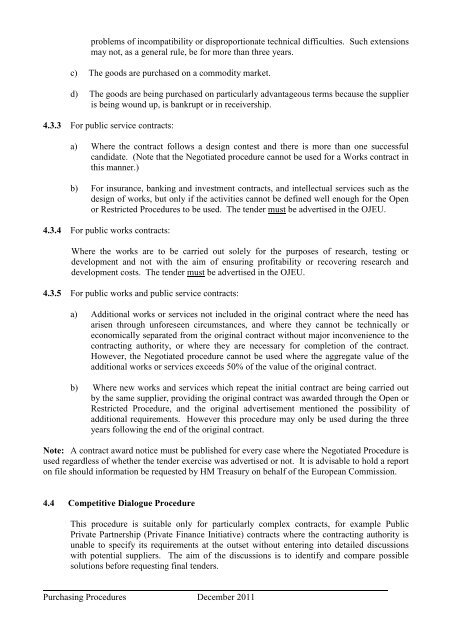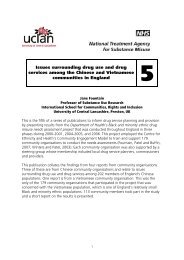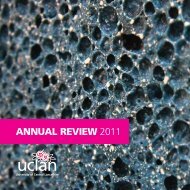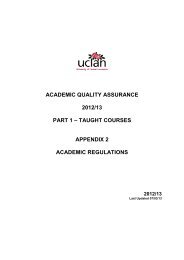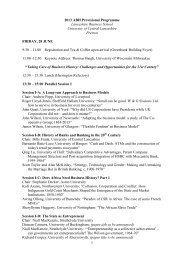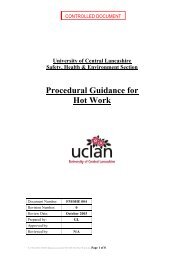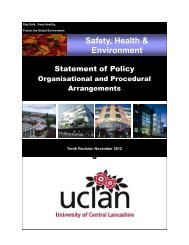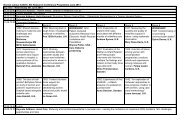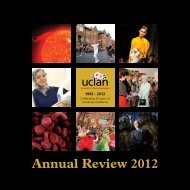PURCHASING PROCEDURES - University of Central Lancashire
PURCHASING PROCEDURES - University of Central Lancashire
PURCHASING PROCEDURES - University of Central Lancashire
You also want an ePaper? Increase the reach of your titles
YUMPU automatically turns print PDFs into web optimized ePapers that Google loves.
problems <strong>of</strong> incompatibility or disproportionate technical difficulties. Such extensions<br />
may not, as a general rule, be for more than three years.<br />
c) The goods are purchased on a commodity market.<br />
d) The goods are being purchased on particularly advantageous terms because the supplier<br />
is being wound up, is bankrupt or in receivership.<br />
4.3.3 For public service contracts:<br />
a) Where the contract follows a design contest and there is more than one successful<br />
candidate. (Note that the Negotiated procedure cannot be used for a Works contract in<br />
this manner.)<br />
b) For insurance, banking and investment contracts, and intellectual services such as the<br />
design <strong>of</strong> works, but only if the activities cannot be defined well enough for the Open<br />
or Restricted Procedures to be used. The tender must be advertised in the OJEU.<br />
4.3.4 For public works contracts:<br />
Where the works are to be carried out solely for the purposes <strong>of</strong> research, testing or<br />
development and not with the aim <strong>of</strong> ensuring pr<strong>of</strong>itability or recovering research and<br />
development costs. The tender must be advertised in the OJEU.<br />
4.3.5 For public works and public service contracts:<br />
a) Additional works or services not included in the original contract where the need has<br />
arisen through unforeseen circumstances, and where they cannot be technically or<br />
economically separated from the original contract without major inconvenience to the<br />
contracting authority, or where they are necessary for completion <strong>of</strong> the contract.<br />
However, the Negotiated procedure cannot be used where the aggregate value <strong>of</strong> the<br />
additional works or services exceeds 50% <strong>of</strong> the value <strong>of</strong> the original contract.<br />
b) Where new works and services which repeat the initial contract are being carried out<br />
by the same supplier, providing the original contract was awarded through the Open or<br />
Restricted Procedure, and the original advertisement mentioned the possibility <strong>of</strong><br />
additional requirements. However this procedure may only be used during the three<br />
years following the end <strong>of</strong> the original contract.<br />
Note: A contract award notice must be published for every case where the Negotiated Procedure is<br />
used regardless <strong>of</strong> whether the tender exercise was advertised or not. It is advisable to hold a report<br />
on file should information be requested by HM Treasury on behalf <strong>of</strong> the European Commission.<br />
4.4 Competitive Dialogue Procedure<br />
This procedure is suitable only for particularly complex contracts, for example Public<br />
Private Partnership (Private Finance Initiative) contracts where the contracting authority is<br />
unable to specify its requirements at the outset without entering into detailed discussions<br />
with potential suppliers. The aim <strong>of</strong> the discussions is to identify and compare possible<br />
solutions before requesting final tenders.<br />
Purchasing Procedures December 2011


